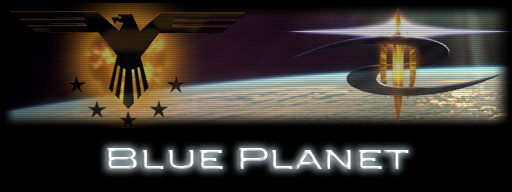Blue Planet intelligence data
| The following information has not been confirmed by Volition and is therefore not canon for the FreeSpace universe. |
|---|
This page references Intelligence entries of the techroom in Age of Aquarius and War in Heaven.
Back to Blue Planet Tech Room data.
- See also: Vishnans
Contents
- 1 The Second Incursion
- 2 The Post-Capella GTVA
- 3 The Rift, Parts 1 and 2
- 4 Vasudan Mysticism, Parts 1 and 2
- 5 Project Nagari, Parts 1 and 2
- 6 The Reunion, Parts 1 and 2
- 7 The Balance of Power, Parts 1 to 5
- 8 The Council of Elders
- 9 The Fedayeen
- 10 Admiral Anita Lopez
- 11 Admiral Cyrus Severanti
- 12 Admiral Chiwitel Steele
- 13 Admiral Robert Byrne
- 14 Admiral Hans Maxwell "H.M." Calder
- 15 Unknown Device Schematics (major spoilers)
The Second Incursion
The GTVA entered the Second Shivan Incursion with the caution and contingent planning appropriate to second contact with a xenocidal alien species. The initial Alliance containment effort was overwhelmingly successful.
No unclassified source has ever explained the decision to enter the Knossos portal and attempt to press the Shivans on their own ground, but all signs suggest that the Security Council and High Command elected to test Shivan strength in order to gather strategic information and perhaps secure a permanent resolution of the Shivan threat. This decision was bolstered by GTVI's initial threat reassessment, placing the Shivans at technological parity with the GTVA.
This bold offensive strategy succeeded longer than pessimists had predicted, and the destruction of the Sathanas juggernaught was seen as analogous to the elimination of the Lucifer 32 years earlier. Shortly afterwards, Vasudan combat elements began to inflict severe damage on what were believed to be Shivan rear-area targets. True strategic victory against the Shivans appeared to be in sight.
But Shivan strategic organization did not collapse after the destruction of the Sathanas, as had been predicted. An overwhelming counterattack made it apparent that the true extent and capabilities of the Shivan species had been vastly underestimated. SOC recon elements supplied evidence that the nebula beyond the Knossos was perhaps only a perimeter element of Shivan space.
In the wake of the destruction of Capella, the Alliance was left reeling. In spite of a modestly successful evacuation effort under severe pressure, civilian confidence in the military was shattered by the sudden strategic turnabout. But the blow was felt on a deeper level.
Humanity, as a species, saw the destruction of Capella as a sign of its own cosmic insignificance. The Lost Generation's dreams of defeating the Shivans and mastering thirty-two-year-old fears were crushed. The Destroyers had brushed mankind aside like a tick and detonated a star with almost playful ease.
Broken, bleeding, and discouraged, suddenly terrified of the vast and impenetrable emptiness and the things waiting in its shadows, mankind turned its attention towards returning to its birthplace.
The Post-Capella GTVA
The Galactic Terran-Vasudan Alliance (GTVA) was formed in 2345, ten years after the Great War. This treaty organization recognized the autonomy of its constituents as it provided a framework for trade and mutual defense. The Great War had transformed the enmity between Terrans and Vasudans into a lasting fellowship.
As the industry and economy of the Terran-Vasudan systems recovered, support for a more powerful GTVA gained momentum. In 2358, delegates signed into existence the Beta Aquilae Convention (BETAC), named after the system where the constitution was drafted and ratified. BETAC dismantled the governments of the Terran blocs and recognized the General Assembly, the Security Council, and the Vasudan Imperium as the supreme authorities of Terran-Vasudan space.
The General Assembly (sometimes referred to as the General Terran Assembly, in a reference to the old GTA) represents the Terran civilian government, while the Vasudan Imperium mirrors its function for the Vasudan species. The Security Council, which includes representatives of both species as well as elements of GTVA High Command and the Admiralty, sets long-term strategic goals, handles military matters, and defines responses to crisis situations.
The GTVA was a state that encompassed billions of diverse peoples and hundreds of cultures, but it was never a nation. It offered its citizens the promise of security and of a future built from hard work, safety, exploration, and vigilant defense. It was an appealing promise, and strategically wise, but it was insufficient to soothe the nihilistic anguish of the Lost Generation. The NTF rebellion exploded out of the Terran need for something to believe in, something more substantial than constant vigilance.
Capella shattered the icons of GTVA security. The Colossus, as much propaganda coup as strategic asset, died in a few inglorious minutes, disabled by a Shivan tactical strike and outmatched by a single Shivan juggernaught. Citizens all across the Alliance saw civilians die by the tens of thousands as the overstretched GTVA tried to protect refugee convoys.
It is debatable whether the GTVA deserved condemnation - its failures were the result of bad intelligence. But, in the wake of Capella, the population turned against the Security Council. Pundits condemned the GTVA as hubristic, militant, arrogant, and bombastic. The phrase 'gambling with the fate of humanity' was thrown about.
The GTVA had offered security. Now, in the popular eye, it was a paper aegis against an unstoppable fire - or, worse, a military junta that had tempted extinction in order to satisfy its own pride.
GTVA analysts saw in this upswelling of discontent a potential end to the GTVA. Conditions across the Alliance echoed those which had preceded the NTF rebellion.
Into this gap stepped the Petrarch Doctrine, the centerpiece of which was the promotion of a return to Earth as a beacon for human salvation. The GTVA offered this plan as a way to placate its constituents. For the past eighteen years, the plan has moved forward, even as discontent stirred on Terran worlds and relationships with the Vasudans grew frosty.
